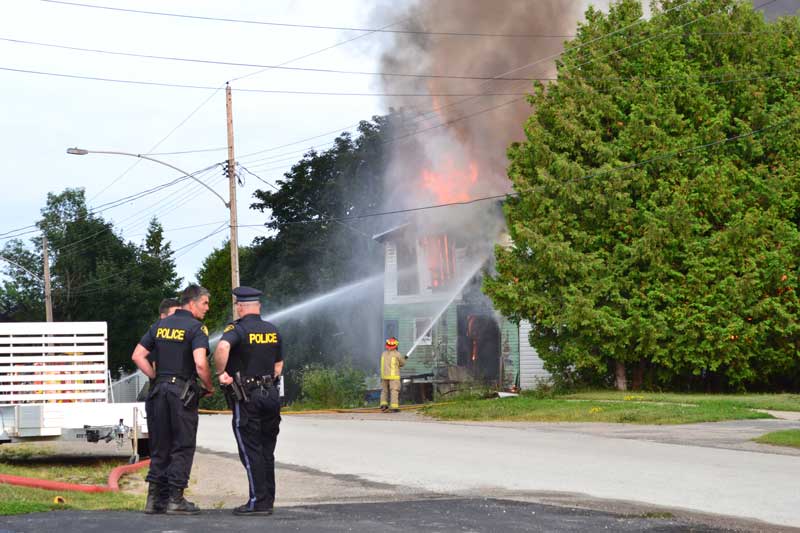MANITOULIN—Local municipal representatives are not surprised, but not impressed either, with the new Ontario Provincial Police (OPP) billing model set out by the province.
“When this issue came up at the FONOM (Federation of Northern Ontario Municipalities) conference a motion was passed to have policing costs uploaded to the province for municipalities with a population of 5,000 or less, but this has obviously been ignored, obviously the province doesn’t listen to municipalities in the North,” stated Gerry Strong, mayor of of Central Manitoulin.
“This release does not come as a surprise to our municipalities, but I think it will be a shock to the general public when they receive their ever-increasing tax bills over the next five years,” said Wayne Bailey, a Burpee-Mills township councillor.
Al Spacek, president of FONOM, said on Tuesday, “policing costs is a contentious issue at the AMO (Association of Municipalities of Ontario) conference this week. We have had two information sessions with the Ministry of Community Safety and Correctional Service and Public Safety and have asked hard questions concerning the increases municipalities are facing.”
“FONOM’s position has been that the costs for policing services should be uploaded by the province for those municipalities with populations of 5,000 or under. They simply took the information and concerns we voiced,” said Mr. Spacek. “At least there is a five year phase in period for this.”
“Today, August 14, 2014, the Ministry of Community Safety and Correctional Services released its new OPP billing model,” said Mr. Bailey in a prepared statement. “This revised billing model under the guise of benevolent intervention to provide a method of recovering provincial policing costs in a way that is equitable to all municipalities in Ontario delivers some expensive downloads of provincial policing responsibilities to the municipalities. Now, part of the policing costs for municipalities is the RIDE (Reduce Impaired Driving Everywhere) program. Will the routine patrols of our provincial highways also be added municipal responsibilities?”
“The province has established the average cost of policing by the OPP as $355 per Ontario household,” wrote Mr. Bailey. “These household calculations still include hunt camps and seasonal homes as well as permanent homes. At this average rate, our policing costs in Burpee Mills would be $117,150. However, since 40 percent of the policing is based on actual calls for service, our municipal policing bill will be somewhat less than that of the provincial average. Fortunately, we have a low crime rate.”
“In response to the political backlash from Northern rural communities when the first drafts of this new policing model were introduced, the province has decided to phase the new policing model over a five year period. This will decrease the shock, giving rural municipalities such as ours time to adjust budgets and tax rates to the increased cost of policing,” continued Mr. Bailey.
“The maximum annual increase in policing costs will be capped at $40 per household. Below, offered as a sample of policing cost increases, are the projected annual cost of policing in Burpee-Mills,” provided Mr. Bailey. They include for 2014=$38,000 (an average policing cost of $115.15 per household); Year No. 1 2015=$51,200, Year No. 2, 2016=$64,400, Year No. 3 2017=77,600, Year No. 4 2018=90,800, Year No. 5 2019=104,000 (an average policing cost of $315 per household).”
“In five years’ time, Burpee-Mills will be paying 273 percent of the 2014 policing costs,” continued Mr. Bailey. “This substantial increase in policing costs will place a hefty burden on all Manitoulin municipalities,” wrote Mr. Bailey.
Mr. Bailey pointed out, “the province has responded positively to some of our municipal concerns: 1-There will be much greater detail reported to municipalities regarding the type of calls for service to be included on the municipal bills to increase transparency. 2-Changing the billing model to increase the calls for service portion of the billing from 25 percent to 40 percent does recognize and reward the relatively crime free Manitoulin municipalities.”
“Today’s new release is definitely not a cheery one, especially at this time when we are visiting the municipal office to pay our land tax bills,” added Mr. Bailey.
“Updating the OPP billing model is about making it fairer, more transparent, and easier to understand,” said Yasir Naqvi, Minister of Community Safety and Correctional Services, in release. “This new model helps ensure that costs to municipalities served by the OPP are shared fairly while enabling communities to direct their crime-prevention efforts towards saving money and keeping their communities safe.”
J.V.N. (Vince) Hawkes, OPP Commissioner said, “the new billing model is a positive step towards achieving greater equity and transparency in OPP municipal policing cost-recovery. it will address concerns brought forward by the Auditor General of Ontario and many of our municipalities. We are moving in the right direction with this model.”
“The OPP is introducing a fairer, more transparent billing model for the municipalities it serves across the province,” a release states. “The new model, which takes effect January 1, 2015 reflects input from the Auditor General and municipalities to more fairly and transparently distribute policing costs.”
The model includes two components: base policing costs such as crime prevention, proactive policing, officer training and administrative duties, and cost for reactive calls for service. Base policing will account for approximately 60 percent of the bill, reactive calls will account for approximately 40 percent, the release continues. “This eliminates the large differences in the amounts municipalities were charged and provides municipalities with better data so they can understand the types of calls for police service in their community and direct crime prevention strategies.”
The average per property cost for OPP services in 2015 is estimated to be $355, compared to an average of $787 (estimated) for self-policed municipalities.
Mr. Naqvi said 207 municipalities will see an increase in policing costs, while 114 will see a decrease. He said the increases will be $100 or less per property, while the decreases will be about $75 per property.
Algoma-Manitoulin MPP Mike Mantha told the Recorder, “the government says this will be a fairer formula but we know a lot of municipalities will be affected greatly. We will work with the municipalities and government to do what we can to make sure the impacts are not great on some municipalities and make sure fairer costs for smaller municipalities will be recognized.”
“I’m not sure the downloading of OPP billing back to the province will be part of that but we will be pushing for this,” said Mr. Mantha.
“FONOM had passed a calling for the province to upload 100 percent of the costs of policing for municipalities with populations of 5,000 or under. We will continue to discuss this with the ministry and we’ll see how this all plays out,” said Mr. Spacek.





